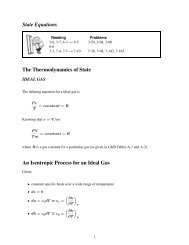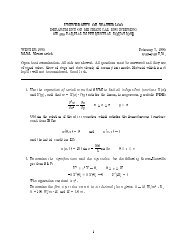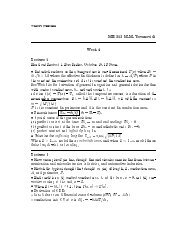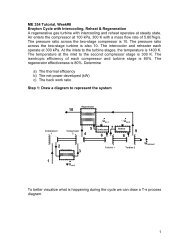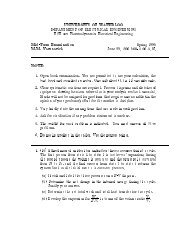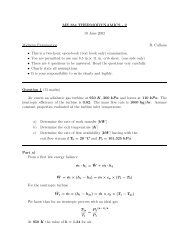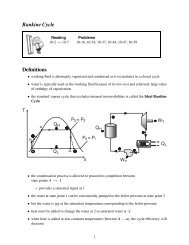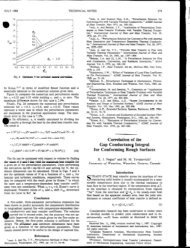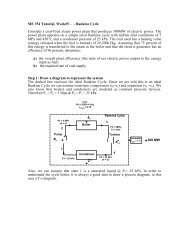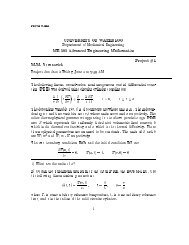Radiation Exchange Between Black and Gray Surfaces
Radiation Exchange Between Black and Gray Surfaces
Radiation Exchange Between Black and Gray Surfaces
- No tags were found...
Create successful ePaper yourself
Turn your PDF publications into a flip-book with our unique Google optimized e-Paper software.
RADEXCHGWEB.TEXECE 309 M.M. Yovanovich<strong>Radiation</strong> <strong>Exchange</strong> <strong>Between</strong> <strong>Black</strong> <strong>and</strong> <strong>Gray</strong> <strong>Surfaces</strong><strong>Radiation</strong> View FactorWhen radiation leaves a black convex surface whose area is A 1 at absolutetemperature T 1 , a certain fraction F 12 will be absorbed by a second convexsurface whose area is A 2 at absolute temperature T 2 < T 1 . The radiationview factor is given by the following relation:A 1 F 12 = A 2 F 21 =ZZA2ZZA1cos 1 cos 2r 2 dA 1 dA 2where r is the radial distance between the centroids of the arbitrary dierentialareas dA 1 <strong>and</strong> dA 2 which are located in the surfaces A 1 <strong>and</strong> A 2 respectively.The angle 1 is subtended by the radius r <strong>and</strong> the outward-directed normal tothe dierential area dA 1 at its centroid. The angle 2 is dened in a similarmanner. In the previous relation F 21 is the fraction of radiation which leavessurface A 2 <strong>and</strong> is intercepted by surface A 1 . The view factors are dimensionlessradiation parameters whereReciprocity RelationThe relation0 F 12 1 <strong>and</strong> 0 F 21 1A 1 F 12 = A 2 F 21is called the reciprocity relation which isvalid for any two convex surfaces. Theview factors for a simple system consisting of two isothermal surfaces the viewfactors have the relations:F 11 + F 12 =1 <strong>and</strong> F 21 + F 22 =1If the surfaces are convex or at F 11 = F 22 = 0. If the surfaces are concave,then 0
The radiation view factors depend on the geometry of the surfaces <strong>and</strong> theirspatial relation to each other. The calculations of the view factors by the aboverelation are usually dicult to do. There are simple techniques available todetermine the view factors for certain axisymmetric systems <strong>and</strong> some innitelylong two-dimensional systems.Radiant <strong>Exchange</strong> <strong>Between</strong> Two Isothermal <strong>Black</strong> <strong>Surfaces</strong>The net radiant exchange between two isothermal black surfaces is given by_Q 12= E b1 , E b2R 12where E b1 = T 4 1 <strong>and</strong> E b2 = T 4 2 are the blackbody radiative nodes <strong>and</strong> R 12 =1=A 1 F 12 =1=A 2 F 21 = R 21 is the spatial radiative resistance between the twosurfaces. The units of R 12 <strong>and</strong> R 21 are m ,2 .The previous relation can be expressed in the following form:_Q 12 = A 1 F 12hT , 4 T 4 1 2iwhich clearly reveals the non-linear nature of radiative heat exchange. Theradiative exchange between two isothermal black surfaces can be representedby a simple thermal circuit consisting of two nodes: E b1 ;E b2 separated by asingle radiative resistance R 12 . The throughput is _Q 12 .Radiant <strong>Exchange</strong> <strong>Between</strong> Two Isothermal <strong>Gray</strong> <strong>Surfaces</strong>The net radiant exchange between two isothermal gray surfaces whose areas areA 1 ;A 2 respectively <strong>and</strong> whose emissivities are 1 ; 2 respectively is given by_Q 12= E b1 , E b2R totalwhere the total radiative resistance now consists of three resistances in series:R totalThe gray surface resistances are given by:= R s1 + R 12 + R s2R s1 = 1 , 1A 1 1<strong>and</strong> R s2 = 1 , 2A 2 2with 0 1 1 <strong>and</strong> 0 2 1. When 1 = 1 <strong>and</strong> 2 = 1 the gray surfacerelation goes to the blackbody relation given above. The equivalent thermal2
circuit consists of two blackbody nodes E b1 ;E b2 <strong>and</strong> two internal nodes denotedJ 1 <strong>and</strong> J 2 which are called the radiosity. The units of radiosity J are identicalto the units of E b . The surface resistance R s1 connects the two nodes E b1 <strong>and</strong>J 1 , <strong>and</strong> the surface resistance R s2 connects the two nodes E b2 <strong>and</strong> J 2 . The tworadiosity nodes are connected by the spatial resistance R 12 . The throughput isthe net radiant exchange _Q 12 .The general gray surface radiant exchange expression gives the following expressionsfor two innite parallel planes, two long concentric circular cylinders, <strong>and</strong>two concentric spheres.Two Innite Parallel PlanesIn this case A 1 = A 2 = A <strong>and</strong> F 12 = 1. Therefore we get_Q 12 = A (E b1 , E b2 )1 1+ 1 2, 1Long Concentric <strong>Gray</strong> Circular CylindersIn this case the inner isothermal cylinder at absolute temperature T 1 <strong>and</strong> whosearea is A 1 =2r 1 L is placed inside the outer cylinder at absolute temperatureT 2 >r 2 >r 1 . The emissivities of the two cylinders are 1 <strong>and</strong> 2 respectively.The net radiative exchange is given by_Q 12 = 2 r 1 L (E b1 , E b2 )1+ r 1 1, 1 1 r 2 2Concentric <strong>Gray</strong> SpheresIn this case the inner isothermal sphere at absolute temperature T 1 <strong>and</strong> whosearea is A 1 =4r 2 is placed inside the outer sphere at absolute temperature1T 2
The expression for two gray spheres gives a simple relation when the outersphere is much larger than the inner sphere, i.e. r 2 >> r 1 . For this case theprevious expression goes to_Q 12 = 1 4 r 2 1(E b1 , E b2 )which is independent of the emissivity <strong>and</strong> surface area of the larger sphere.The emissivity <strong>and</strong> the surface area of the smaller sphere control the radiativeexchange between the two surfaces.4



